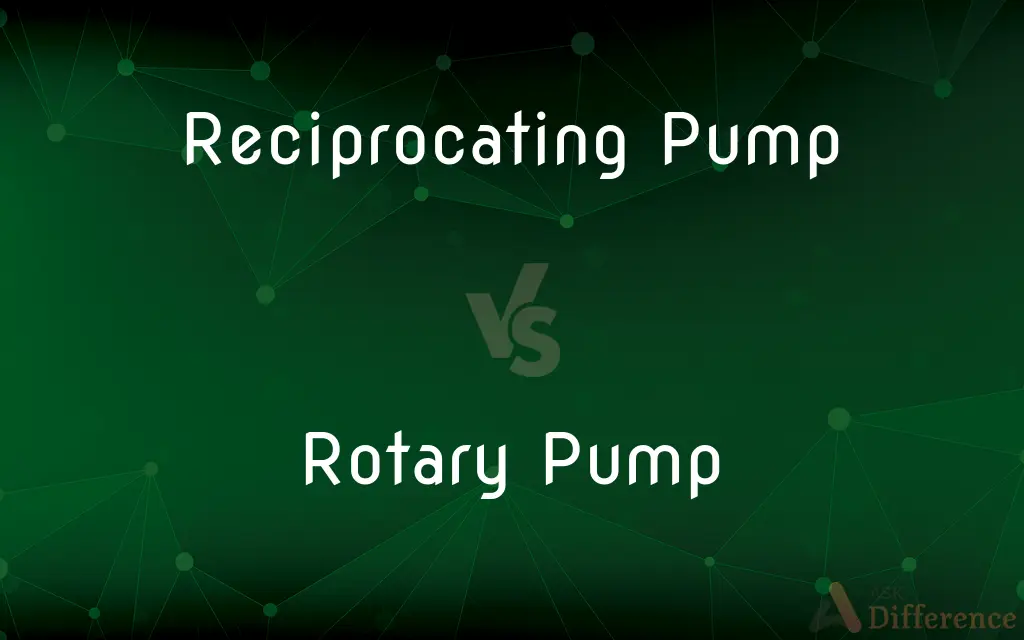Reciprocating Pump vs. Rotary Pump — What's the Difference?
By Tayyaba Rehman — Published on November 10, 2023
Reciprocating Pump: Uses a piston & cylinder mechanism to move fluid. Rotary Pump: Utilizes a rotating device to transfer fluid steadily.

Difference Between Reciprocating Pump and Rotary Pump
Table of Contents
ADVERTISEMENT
Key Differences
Reciprocating Pumps are a type of pump where the fluid is moved using a piston that moves back and forth in a cylindrical chamber. In contrast, Rotary Pumps involve the use of a rotating mechanism, typically a vane, gear, or lobe, to push the fluid through the pump. Both are utilized for their unique capabilities in various industrial applications, with reciprocating often favored for high-pressure, low-flow applications, and rotary for steady, continuous flow.
In a Reciprocating Pump, the back-and-forth movement of the piston creates a pressure differential, which allows fluid to be moved through the pump. The Rotary Pump, meanwhile, often provides a smoother, continuous flow due to the constant rotation of its mechanisms. The reciprocating pump, with its cyclical motion, generates pulsations in the fluid flow, while the rotary pump’s operation minimizes pulsations.
A notable aspect of Reciprocating Pumps is that they are known for their ability to generate high pressure, making them suitable for applications like hydraulics and high-pressure spraying. On the other hand, Rotary Pumps tend to be favored for applications where a consistent, pulseless flow is desired, such as in fluid transfer in certain manufacturing processes and in hydraulic power applications.
Reciprocating Pumps often tend to have higher maintenance requirements due to the wear and tear on the piston and cylinder from the reciprocating motion. Comparatively, Rotary Pumps may have reduced wear and tear due to the lack of reciprocating components and often provide more silent operation, which might be a deciding factor in certain applications.
The efficiency of Reciprocating Pumps can be quite high, especially in scenarios that require the pumping of viscous fluids. Rotary Pumps are often celebrated for their ability to handle fluids with varying viscosities and their self-priming capabilities, making them quite versatile across various industries.
ADVERTISEMENT
Comparison Chart
Basic Mechanism
Piston moving in a cylinder
Rotating device like a vane or gear
Flow Characteristics
Pulsating flow
Steady, continuous flow
Pressure Capabilities
Generally higher pressure capabilities
Typically lower pressure capabilities
Typical Applications
High-pressure, low-flow scenarios
Scenarios requiring smooth fluid transfer
Maintenance and Wear
Often higher due to reciprocating parts
Typically lower due to continuous motion
Compare with Definitions
Reciprocating Pump
Involves a back-and-forth motion to generate flow.
The persistent mechanical issue hindered the back-and-forth motion of the Reciprocating Pump.
Rotary Pump
Capable of handling fluids with varying viscosities.
The Rotary Pump efficiently moved the fluids of disparate viscosities.
Reciprocating Pump
Suitable for high-pressure applications.
For the high-pressure hydraulic system, a Reciprocating Pump was chosen.
Rotary Pump
It can often self-prime, aiding in versatile applications.
The Rotary Pump’s self-priming capability expedited the fluid transfer process.
Reciprocating Pump
Tends to generate a pulsating fluid flow.
Engineers used dampeners to minimize the pulsations from the Reciprocating Pump.
Rotary Pump
A Rotary Pump utilizes a rotating mechanism to move fluid.
The Rotary Pump ensures a steady transfer of the cooling fluid.
Reciprocating Pump
May require regular maintenance due to wear.
Routine checks are vital to ensure the Reciprocating Pump operates effectively.
Rotary Pump
Often chosen for applications requiring consistent flow.
To avoid disruptions, a Rotary Pump was employed in the production line.
Reciprocating Pump
A Reciprocating Pump uses a piston's motion to pump fluid.
The Reciprocating Pump efficiently moved the viscous fluid through the system.
Rotary Pump
Typically offers quiet and smooth operation.
The silent operation of the Rotary Pump is ideal for noise-sensitive areas.
Common Curiosities
Can Reciprocating Pumps handle viscous fluids?
Yes, they can efficiently pump viscous fluids and generate high pressures.
What is a Reciprocating Pump?
It is a pump that uses a reciprocating piston and cylinder mechanism to move fluid.
Where are Reciprocating Pumps commonly used?
They are often used in high-pressure, low-flow applications like hydraulics.
Are Rotary Pumps quieter than Reciprocating Pumps?
Generally, Rotary Pumps tend to operate more quietly and smoothly.
What defines a Rotary Pump?
A Rotary Pump utilizes a rotating mechanism, such as a vane or gear, to pump fluid.
What is a typical application for a Rotary Pump?
Rotary Pumps are commonly used where a steady, pulseless fluid flow is desired.
What type of flow is generated by a Reciprocating Pump?
Reciprocating Pumps typically generate a pulsating flow.
Can a Reciprocating Pump handle various fluid types?
Yes, it can handle different fluids, especially those requiring high-pressure transfer.
Do Reciprocating Pumps require regular maintenance?
Yes, due to wear from reciprocating motion, they might need frequent maintenance.
How do Rotary Pumps manage varying fluid viscosities?
They are often capable of handling fluids of various viscosities with steady flow.
What makes Rotary Pumps self-priming?
Their design and continuous flow capability often enable Rotary Pumps to self-prime.
What causes wear in Reciprocating Pumps?
Wear in Reciprocating Pumps often comes from the reciprocating motion of its components.
Is a Rotary Pump suitable for high-pressure applications?
Typically, Rotary Pumps are less suited for high-pressure applications compared to Reciprocating Pumps.
How smooth is the flow in a Rotary Pump?
Rotary Pumps usually provide a consistent and smooth flow of fluid.
Can both Reciprocating and Rotary Pumps be used in industrial applications?
Yes, both are used in various industrial applications, chosen based on specific use-case requirements.
Share Your Discovery

Previous Comparison
Probability Sampling vs. Non-Probability Sampling
Next Comparison
Steroids vs. AntibioticsAuthor Spotlight
Written by
Tayyaba RehmanTayyaba Rehman is a distinguished writer, currently serving as a primary contributor to askdifference.com. As a researcher in semantics and etymology, Tayyaba's passion for the complexity of languages and their distinctions has found a perfect home on the platform. Tayyaba delves into the intricacies of language, distinguishing between commonly confused words and phrases, thereby providing clarity for readers worldwide.












































